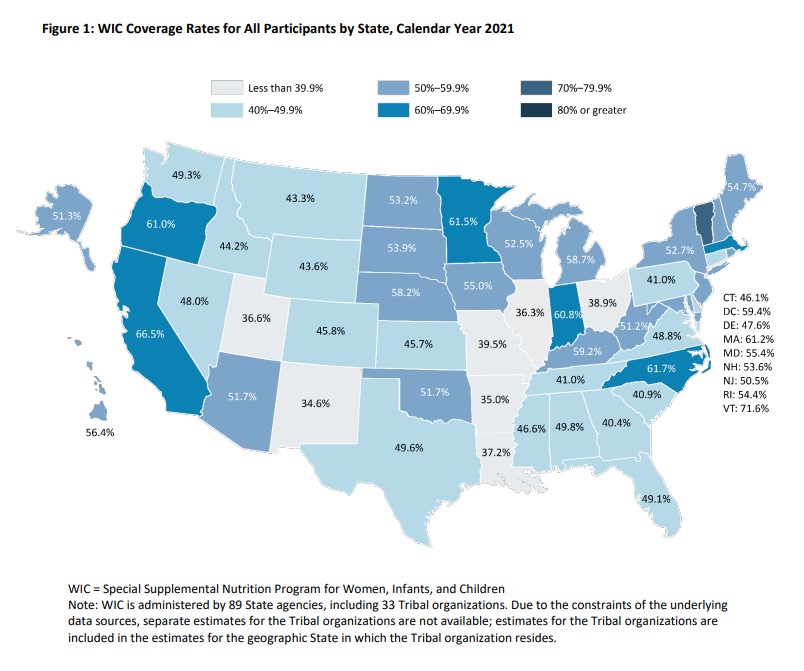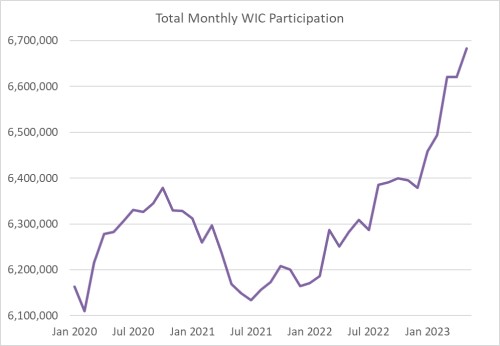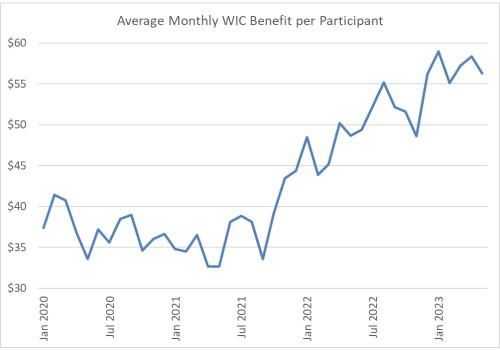The Women, Infants and Children (WIC) program serves only half of eligible participants, and USDA and WIC supporters want to see the program continue to expand to reach all those who qualify.
Of the nearly 12 million eligible pregnant women, nursing mothers and young children, only 51% on average participate nationally, as identified by USDA in its latest 2021 participation rates. Some states were well below the national average, with seven under 40%, while seven saw levels of participation at 60% or higher. In 29 states, the WIC coverage rate was less than 50%.
“The report that we put out really speaks to a challenge that WIC has, which is we’re not reaching all eligibles,” said Stacy Dean, USDA deputy undersecretary for Food, Nutrition and Consumer Services. “We have a lot of work to do to connect this incredibly evidence-based program to families in need.”
The WIC program offers supplemental food assistance to pregnant women, mothers and infants and children up to their fifth birthday. For infants, it offers formula, but for all eligible participants it provides prescriptive food needs based on the National Academy of Sciences, Engineering and Medicine’s recommendations.
“They give us very specific recommendations about how to think about how to supplement the diets of our participants with those things that they’re missing overall,” Dean said.
Dean said one group that has the “most ground to gain” is pregnant women. Only 40% of pregnant women participate in the program, and an ever lower 33% of postpartum women, according to the report.
Geri Henchy, director of nutrition policy and early childhood programs at the Food Research and Action Center (FRAC), noted that participation rates for pregnant women can sometimes be skewed because women don’t always enroll in the program for the entire nine months. She said most of the high number for infant participation is because the mother was on WIC for at least some part of her pregnancy.
Coverage rates were highest for Hispanic WIC-eligible individuals (58.1%) and lowest for non-Hispanic White WIC-eligible individuals (44.2%). Participation rates for children decreased with age, from a high of 64% for 1-year-olds to a low of 25% for 4-year-olds, the report stated. Overall, child participation increased, up 2.4% from 2020.
Nell Menefee-Libbey, public policy manager at the National WIC Association, said the slight increase in coverage among children is “really encouraging because we know that has historically been a group that is most likely to be underserved.”
She added this “absolutely tracks with the sort of raw participation numbers that we’ve been looking at, which have shown a huge increase in child participation over the past couple of years.”
Henchy said many of the states that came in above the historical average have historically had high rates, such as Vermont, at nearly 72%. “Many of these trends are historic,” Henchy said, explaining that Vermont works closely with healthcare providers to increase program awareness.
 Mollie Van Lieu, International Fresh Produce Association vice president of nutrition and health policy, said if there were a consistent rate across all states it may point to challenges with enrollment or delivery. However, she's led to believe it’s more about administration, communication or education differing from state to state that creates barriers for participation.
Mollie Van Lieu, International Fresh Produce Association vice president of nutrition and health policy, said if there were a consistent rate across all states it may point to challenges with enrollment or delivery. However, she's led to believe it’s more about administration, communication or education differing from state to state that creates barriers for participation.
Currently the fruit and vegetable redemption rate is between 70-80%, she said. She hears from participants they’re concerned about going over the allowed levels. With the acceptance of online WIC benefits, she believes participants will redeem at even higher amounts.
Van Lieu said IFPA members recognize that if utilized by all eligible individuals , the WIC benefit could add an additional $4 billion in fruit and vegetable demand at the retail level. IFPA members are looking at ways to improve education about the health benefits of fruits and vegetables.
One of the reasons some states have struggled to increas e participation is their WIC EBT card reloading is not remote, which requires participants to still come into a physical office each month to reload their benefits, said Henchy.
e participation is their WIC EBT card reloading is not remote, which requires participants to still come into a physical office each month to reload their benefits, said Henchy.
WIC waivers and enhancements during the pandemic have simultaneously removed access barriers and increased the value of participating in WIC, resulting in overall increases in program participation. In February 2022, WIC reached 6.2 million participants, a 1.2% increase from February 2020, according to a FRAC report issued last year looking specifically at that time period following the pandemic’s onset.
Menefee-Libbey said this shift to remote services for signing up for the program during the pandemic “created an opportunity to reach families who may not have otherwise been engaged in the program” by allowing working parents to certify or recertify over the phone, rather than taking a bus or driving an hour to a WIC center.
“Then the idea of continuing to participate, even as your children get older, I think was more attractive to people because it was easier to do,” Henchy added.
It’s easy to be “in the know” about what’s happening in Washington, D.C. Sign up for a FREE month of Agri-Pulse news! Simply click here.
Henchy said people have an increased need, as many have seen other nutrition program benefits decrease and the elimination of the child tax credit. During the pandemic, the WIC food package also allowed a dollar amount to be used towards fruits and vegetables, which is another attractive enticement to continue on in the program.
“The average value of the food package has skyrocketed,” which Henchy said correlates to the increase in the consumer price index for food. “One of the really important and valuable things for the WIC food package is that it safeguards WIC participants against inflation, with the exception of fruit and vegetable vouchers.”
Dean also said USDA is looking at the pain points for WIC participants that may hinder participation, whether that’s par t of the shopping experience, whether foods are properly labeled as WIC, and other potential barriers.
t of the shopping experience, whether foods are properly labeled as WIC, and other potential barriers.
“We’re doing research with participants, program leaders and stores to figure out where all of our strengths and areas of growth, and then trying to make sure we’re backing states up with high-impact investments to improve those friction points so that we can increase access,” Dean said.
Congress authorized and USDA executed with partners education and outreach benefits to improve program participation rates. Current WIC participation is 6.7 million people, and Dean said in the last year 400,000 people joined the program.
FRAC received a grant from USDA to help expand partnerships with community organizations to test and improve WIC outreach efforts.
“I want to emphasize that the gains that we’ve seen in program participation in recent years are the result of a decade’s worth of work being done by state and local WIC providers to get more eligible individuals connected to the program,” Menefee-Libbey said. “Those gains are really hard won, and it’s important that we don’t take them for granted.”
Menefee-Libbey warned if Congress fails to adequately resource the program, it would undercut recent increases in participation.
“If there is a conception among eligible individuals that they may not be able to participate in the program because those resources are finite, I would hate to see the impact that could have on participation moving forward,” she said.
For more news, visit www.Agri-Pulse.com.


